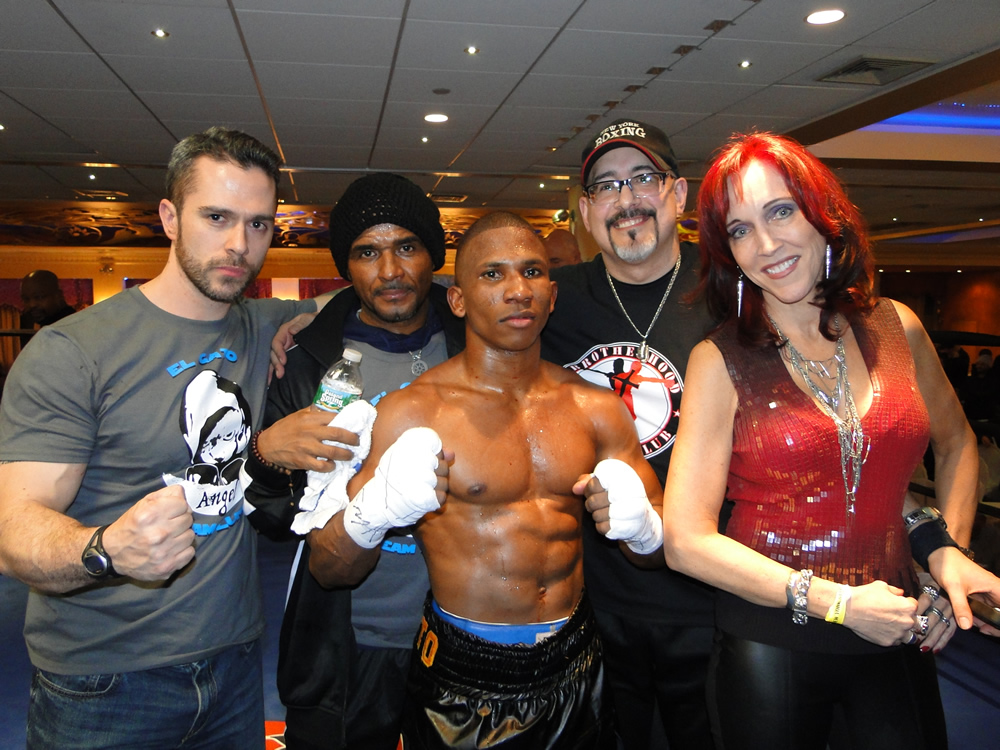Premier Boxing Champions on NBC Comes to Barclays Center with Two Sensational Main Events
 |
| Monsignor Jamie Gigantiello, John Duane, Dr. Pietro Baio and Peter Quillen |
- Televised Fights on NBC Start at 8:30 P.M. ET -
Tickets on Sale Tomorrow!
BROOKLYN (February 12, 2015) - The eagerly awaited showdown between undefeated superstar Danny "Swift" Garcia (29-0, 17 KOs) and Lamont Peterson (33-2-1, 17 KOs) will become a reality as Premier Boxing Champions (PBC) on NBC returns to primetime on Saturday, April 11 at 8:30 p.m. ET live from Barclays Center in Brooklyn.
In the first main event of the evening, middleweight world champion "Irish" Andy Lee (34-2, 24 KOs) takes on the undefeated Peter "Kid Chocolate" Quillin (31-0, 22 KOs) in a 12-round world title fight.
Marv Albert will call the fights in primetime on NBC alongside analyst "Sugar" Ray Leonard, the six-time world champion and 1976 Olympic gold medalist. Al Michaels will host.
Tickets for the live event, which is promoted by DiBella Entertainment, are priced at $300, $200, $100 and $50 not including applicable service charges and taxes, and are on sale tomorrow, Friday, Feb. 13 at 10 a.m. Tickets are available at www.barclayscenter.com, www.ticketmaster.com and at the American Express Box Office at Barclays Center starting on Saturday, Feb. 14 at noon. To charge by phone, call Ticketmaster at (800) 745-3000. For group tickets, please call 800-GROUP-BK.
"It's an honor to be fighting back in Brooklyn where I've experienced some of the best moments of my career," said Garcia. "Fans have been asking for this fight for so long and on April 11 I'm planning on giving them the show they've been waiting for. Doing it live on NBC will make it even sweeter."
"This is an amazing opportunity for me fighting in Brooklyn and on national TV in front of millions of people," said Peterson. "I'm going to go out there and give the performance of a lifetime. Danny Garcia better not underestimate me, because my time is now."
"I'm looking forward to returning to New York and defending my title against Quillin," said Lee. "I'm at the peak of my powers now. I cannot see myself losing to anyone. I want to be recognized as the best middleweight in the world and beating Quillin will go some way to proving that."
"To be able to fight at home in Brooklyn and win a title on such a big stage is a dream come true," said Quillin. "I'm honored and excited to be a part of something that is great for my career, but also for the sport of boxing as a whole. I know that I'm going to win on April 11, become champion once again, and then I'm going after anyone and everyone at 160 pounds."
"I am thrilled to be promoting this PBC mega event at Barclays Center in my hometown of Brooklyn," said Lou DiBella, President of DiBella Entertainment. "Danny Garcia vs. Lamont Peterson and Andy Lee defending his middleweight title against Peter Quillin are two of the very best bouts that can be made in boxing. On April 11, the fans are going to be the biggest winners and DBE is proud to be part of it."
"Quality championship fights are only in Brooklyn in April," said Brett Yormark, CEO of Barclays Center. "Danny Garcia always brings excitement to our ring and we are delighted once again to have Brooklyn's own Peter Quillin fighting in Barclays Center. Fans want drama and unpredictable fights, and we are confident our card will deliver that on primetime television."
Now in his fourth year as a world champion, Philadelphia's Garcia will return to headline at Barclays Center for a record fourth time. Garcia also fought in the main event in October 2012, the first ever-boxing card at Barclays Center. The 26-year-old has taken down some of the biggest names in boxing on his way to an undefeated record, including Amir Khan, Erik Morales, Zab Judah and Lucas Matthysse. He will once again have a chance to prove himself against the best, this time in the long anticipated clash with Peterson.
Washington, D.C.'s Peterson is a gifted boxer-puncher with as much heart as talent. Like Garcia, the 31-year-old Peterson is another longtime champion. Peterson has always faced the best and defeated Amir Khan in 2011. The only blemishes on his perfect record came against Timothy Bradley and Lucas Matthysse. He is coming off of two impressive victories in 2014 and now he gets the bout he and the public have clamored for as he takes a shot at beating Garcia in Brooklyn.
An accomplished amateur who was Ireland's sole boxing representative at the 2004 Olympic Games, Leegot his first taste of world championship gold in December 2014 when he defeated Matt Korobov for the vacant middleweight world title with a sensational sixth round technical knockout. The 30-year-old has fought in his home country of Ireland, the UK, Germany and most often in the U.S. throughout his career. His only career losses came against Bryan Vera, which he would later avenge and Julio Cesar Chavez in his first world title fight. On April 11, Lee will fight for the fifth time in New York City, looking to give the primetime national television audience a memorable night.
A former world champion looking to reclaim the belt he vacated last year, Quillin will return to the same arena where he won the middleweight belt in 2012 with his star-making, six-knockdown performance against Hassan N'Dam in the first boxing card hosted by Barclays Center. Born in Chicago but fighting out of New York City, the 31-year-old went on to defend that title against strong contenders Fernando Guerrero, Gabriel Rosado and Lukas Konecny. Now, "Kid Chocolate" looks to show off his superstar skills to a primetime audience.
Beginning with the first show, Saturday, March 7, at 8:30 p.m. ET on NBC, NBC and NBCSN will present 20 live "PBC on NBC" boxing events in 2015. Within the 20 live shows, NBC Sports Group will present more than 50 hours of PBC coverage, including NBCSN pre- and post-fight programming for NBC telecasts. The Premier Boxing Champions series is created for television by Haymon Boxing. The PBC on NBC will feature many of today's brightest stars, in their most compelling matches.
All PBC on NBC shows will be streamed live on NBC Sports Live Extra via "TV Everywhere," giving consumers additional value for their subscription service, and making high quality content available to MVPD customers both in and out of the home and on multiple platforms. NBC Sports Live Extra is available for desktops at NBCSports.com/liveextra. The NBC Sports Live Extra app is available at the App Store for iPad and iPod touch, on select devices within Google Play, and on windows phones and tablets.
# # #
For more information visit www.premierboxingchampions.comwww.nbcsports.com/boxing,www.BarclaysCenter.com and www.dbe1.com, follow on Twitter @PremierBoxing, @DiBellaEnt, @DannySwift, @KingPete26, @KidChocolate, @AndyLeeBoxing, @NBCSports and @BarclaysCenter and become a fan on Facebook at www.Facebook.com/PremierBoxingChampions,www.facebook.com/NBCSports and www.facebook.com/DiBellaEntertainment. Follow the conversation using #PremierBoxingChampions and #BKBoxing.















